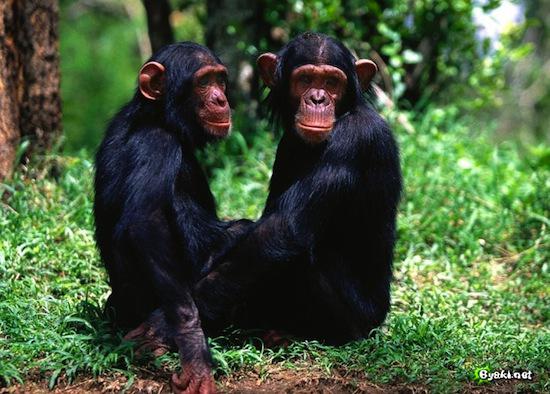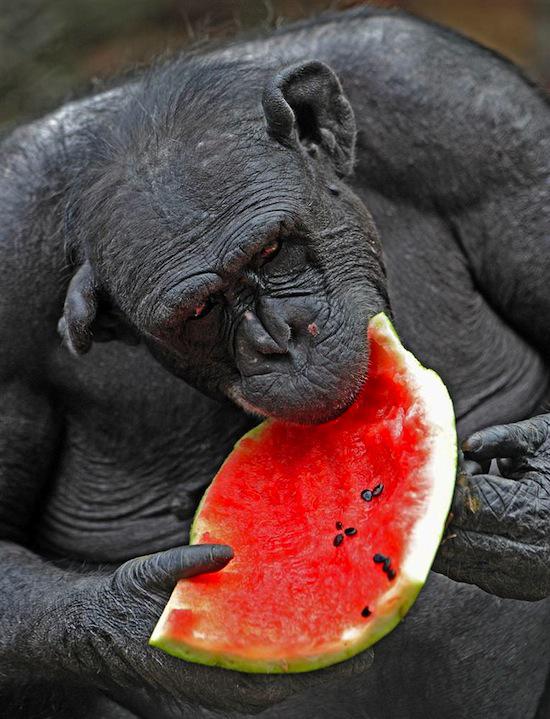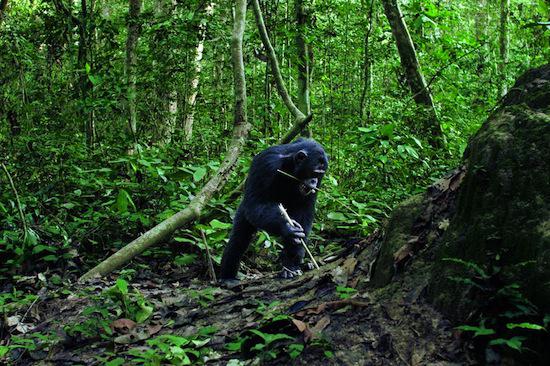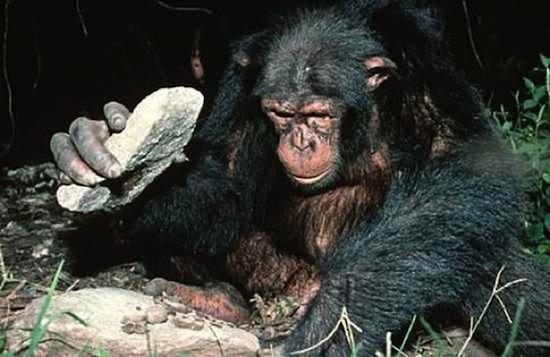1020
10 facts about the similarities and differences between humans and chimpanzees

Although chimpanzees are our closest relatives, they were still unknown in most of the world, as long as Charles Darwin wrote about them in 1859 and they became popular. Only recently it was discovered many hitherto unknown information to take another look at the errors and exaggerations, abundantly used in works of fiction. Nevertheless, our similarities and differences are not such as many of them are themselves. By studying our closest relatives, we can better understand ourselves.
1. Number of vidov

Chimpanzees often incorrectly referred to as monkeys, but they really only apply to a large family of monkeys, as we are. Other primates are outstanding representatives of orangutans and gorillas. There is only one kind of person now is homo sapiens. In the past, many scientists have tried to prove that there are several types of human and often hasten to add that they belonged to a "higher" species. However, all people can produce offspring of their own kind, and so we are all one species. With regard to the chimpanzee, in fact there are two types: pan troglodytes, is the common chimpanzee and pan paniscus, or bonobo chimpanzees slim. These two species of chimpanzees are entirely separate species. Humans and chimpanzees, as species evolved from a common ancestor, perhaps from sahelanthropus tchadensis, about five to seven million years ago. From this ancestor were only fossils.
2. DNK

It is often said that the human and chimp DNA is the same at 99%. Genetic comparisons difficult task, because of the nature of genetic mutations, so that a more accurate estimate is somewhere between 85% and 95%. Although this figure may sound impressive, it is proved that the DNA is used by all living beings for basic cellular functions. For example, we have about half of the same DNA, and banana, and yet no one focuses on that fact to show how people can be like a banana! Thus, 95% do not speak so much as it seems at first glance. Chimps have 48 chromosomes, two more than a man. It is believed that this legacy of human ancestor, two pairs of chromosomes coalesce into a single pair. Interestingly, the man has the smallest genetic variations among vsehzhivotnyh, why incest can cause genetic problems. Even two completely unrelated person, as a rule, is genetically more similar than two brothers chimpanzees.
3. Size mozga

Chimpanzee brain has an average volume of 370 cc On the other hand, people have an average brain size of about 1350 cubic meters. cm. However, the brain and its size alone is not an absolute measure of intelligence. Several Nobel Prize winners have had less brain volume of 900 cubic meters. cm., and some - of more than 2000 cc. see. The structure and organization of the different parts of the brain is the best way to define intelligence. The human brain has a large surface area, so it has more convolutions than the brain of a chimpanzee, and therefore, the human brain has a greater number of connections between the parts of the brain. As well as a relatively large frontal lobe allows us to have a much more developed abstract and logical thinking.
4. Social kommunikabelnost

Chimpanzees spend a lot of time to chat. Most of their communication is to care for each other. Juvenile and young chimpanzees often play, run one after the other, and tickle each other. Adult chimpanzees are also often play with their offspring. Attending include hugging and kissing, it occurs between the chimpanzees of any age and gender. Bonobos especially candid and almost every manifestation of attention has sexual overtones, regardless of gender. Chimpanzees strengthen friendship and spend a lot of time together, caring for each other. People also spend on communication about the same time, but we do it more often verbally than physically. However, much of the vast number of meaningless chatter, it is simply a more sophisticated version of chimpanzee behavior - and it is slightly different purposes than to strengthen our ties. People also show a close relationship through physical contact - a friendly pat on the back or a hug. The size of social groups of primates accurately reflect the size of their brain. Chimpanzees have about 50 close friends and acquaintances, while a person of from 150 to 200.
5. Language and mimika

Chimpanzees have sophisticated systems of greetings and messages that depend on the social status of communicating chimpanzees. They communicate orally, using a variety of cries, grunts and other vocalizations. Most of their communication, however, by means of gestures and facial expressions. Many of their facial expressions - surprise, smiles, facial expressions and gestures appealing comfort - the same as in humans. Nevertheless, people are smiling, showing his teeth, that chimpanzees and many other animals is a sign of aggression or threat. Most human communication by means of vocalization. People definitely have a more sophisticated vocal cords, allowing them to play a large range of sounds, but also prevents them drink and breathe at the same time as it makes chimpanzees. In addition, people are very muscular tongue and lips, enabling them to produce precise manipulation of their votes. That is why people have pointed chin, while the chimpanzees he downhill - has the majority of the labial muscles in the lower jaw near the chin, but the chimpanzee does not have many of these muscles, and therefore they do not need prominent chin.
6. Pitanie

Chimpanzees and humans are omnivores (eat plants and meat). People are more carnivorous than chimps, and have a small intestine for digestion of meat. Chimpanzees sometimes hunt and kill other mammals, often other monkeys, but otherwise chimpanzees content of fruit and sometimes insects. People are much more dependent on the meat - people can get vitamin B12 naturally only from animal products. Based on our digestive system and way of life of the surviving tribes, it is believed that humans evolved eating meat at least once every few days. People also tend to receive food on a schedule rather than the continuous power during the day, which is a feature of other carnivores. This may be due to the fact that the meat may be available only after a successful hunting, and therefore eaten in large quantities, but infrequently. Chimpanzees will eat fruit throughout the day, while most people will not eat more than three meals a day.
7. Sex
Bonobos are known for their sexual appetite. Ordinary chimps can get angry or behave aggressively, but bonobos relieve tension through sexual pleasure. They also greet each other and show their affection for each other through sexual arousal. Common chimpanzee does not use sex as entertainment, and mating takes only ten or fifteen seconds, often during meals or during other activities. Friendship and emotional attachments have nothing to do with the common chimpanzee who communicates, and females during estrus usually mate with several males, sometimes patiently waiting for their turn to each other. People experience sexual pleasure as bonobos, sex for reproduction but takes much longer and requires more effort, resulting in formation of long-term partnerships. Unlike humans, chimpanzees do not have any idea about sexual jealousy or rivalry, since they do not have long-term partners.
8. Pryamohozhdenie

And the man and chimpanzees are bipedal creatures and can walk on two legs. Chimpanzees often make is to look on, but prefer to walk on all fours. People go straight from childhood, and they have evolved a bowl-shaped basin to support their internal organs. Chimpanzee walking, leaning forward on the road, so that the pelvis does not support their bodies, and they have wider hips. This makes deliveries for a chimpanzee is much easier than for a person who has a cup-shaped basin is on the way big birth canal. The man has straight legs, toes are arranged in front for easy walking, while chimpanzees have a bulge of the big toe, and their feet are more like hands. They use legs for climbing and crawling sideways, diagonally, or rotational movements.
9. Glaza

In humans, the iris is white, while the iris chimpanzees typically a dark brown color. This makes it easier to see where a person is looking, and there are several theories why this is so. It can be adapted to more complex social situations when it is beneficial to see someone look at the other, and what they think at the same time. This can help with the hunt in silence, where the direction of the eye is very important for communication. Or it could just be a genetic mutation without any purpose - some chimps also have a white iris of the eye. And the man and the chimpanzee can see in color, which helps them to choose to eat ripe fruits and plants, have binocular vision, their eyes facing the same direction. It helps to see in depth and more important during the hunt than the eye on the opposite sides of the head, like a rabbit, which helps them avoid being caught.
10. Guns truda

For many years it was thought that only humans among the animals use tools. Observations of chimpanzees, conducted in 1960, showed the use of sharpened branches to catch termites, but since then much has changed. And the man and chimpanzees are able to change the environment to create tools to solve everyday problems. Chimps make spears, use stones as hammers and anvils, shredded leaves to be used as a temporary sponge. It is believed that as a result of bipedalism, our forelimbs much more free-to-use tools, and we use the tools built into art. We live in a constantly surrounded by the products of our abilities, and much of what people believe, makes us "success" is rooted in our tool production.
via factroom.ru























